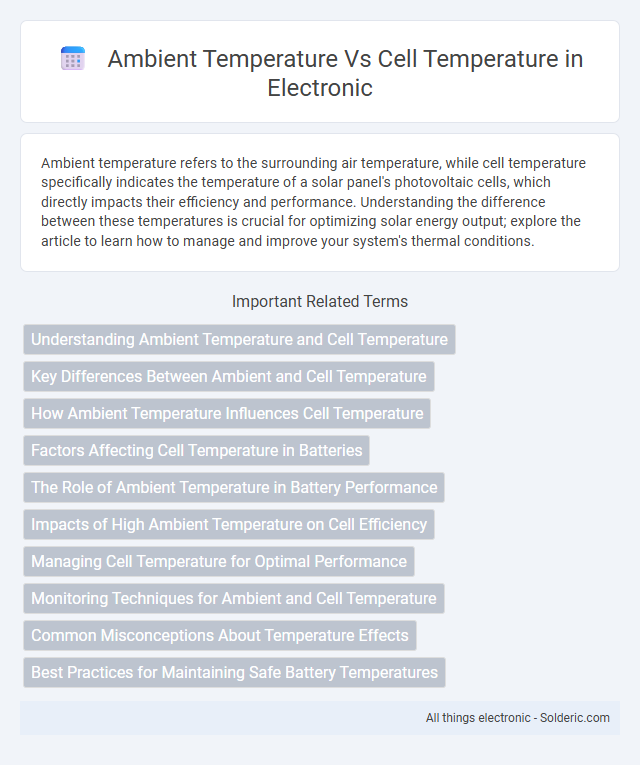Ambient temperature refers to the surrounding air temperature, while cell temperature specifically indicates the temperature of a solar panel's photovoltaic cells, which directly impacts their efficiency and performance. Understanding the difference between these temperatures is crucial for optimizing solar energy output; explore the article to learn how to manage and improve your system's thermal conditions.
Comparison Table
| Aspect | Ambient Temperature | Cell Temperature |
|---|---|---|
| Definition | Temperature of the surrounding air around a system or object. | Temperature of an individual cell, often a battery or solar cell, during operation. |
| Measurement Location | External environment, typically measured in shade or open air. | Directly on or inside the cell or module surface. |
| Impact | Affects overall system cooling and ambient conditions. | Directly influences performance, efficiency, and lifespan of the cell. |
| Typical Range | -40degC to 50degC depending on climate and conditions. | Often higher than ambient; can exceed 70degC during high load. |
| Relation | Baseline environmental temperature. | Generally equals ambient plus heat generated by cell operation. |
| Relevance | Key for system installation and safety standards. | Critical for thermal management and cell reliability. |
Understanding Ambient Temperature and Cell Temperature
Ambient temperature refers to the surrounding environmental air temperature, while cell temperature is the actual temperature of the solar panel's photovoltaic cells during operation. Cell temperature is typically higher than ambient temperature due to heat generated by solar radiation and electrical losses within the cells. Understanding this difference is crucial because elevated cell temperatures can significantly reduce solar panel efficiency and overall energy output, impacting your system's performance.
Key Differences Between Ambient and Cell Temperature
Ambient temperature refers to the surrounding environmental temperature, while cell temperature specifically measures the heat within a photovoltaic (PV) cell during operation. Cell temperature is typically higher than the ambient temperature due to sunlight absorption and electrical resistance, significantly impacting solar panel efficiency. Understanding the difference helps You optimize solar system performance by managing heat dissipation and selecting appropriate materials.
How Ambient Temperature Influences Cell Temperature
Ambient temperature directly affects cell temperature by determining the baseline heat level surrounding the photovoltaic modules or battery cells. Higher ambient temperatures increase the heat absorbed and retained by cells, leading to elevated operating temperatures that reduce efficiency and accelerate degradation. Effective thermal management systems are essential to mitigate the impact of ambient temperature fluctuations on cell performance and longevity.
Factors Affecting Cell Temperature in Batteries
Cell temperature in batteries is influenced by ambient temperature, battery load, and internal resistance during operation. Higher ambient temperatures can increase cell temperature, while poor ventilation and high discharge rates further elevate heat generation within the battery. Monitoring these factors helps maintain your battery's efficiency and prolong its lifespan by preventing overheating and thermal degradation.
The Role of Ambient Temperature in Battery Performance
Ambient temperature significantly influences battery performance by affecting the cell temperature, which directly impacts the battery's efficiency, capacity, and lifespan. Higher ambient temperatures cause an increase in cell temperature, accelerating chemical reactions within the battery, leading to faster degradation and potential safety risks. You should monitor ambient conditions carefully to optimize battery management systems and ensure reliable performance in varying environmental settings.
Impacts of High Ambient Temperature on Cell Efficiency
High ambient temperature significantly reduces photovoltaic cell efficiency by increasing cell temperature beyond optimal levels, causing higher internal resistance and accelerated electron recombination. Elevated cell temperature decreases voltage output and overall power generation, impacting system performance and energy yield. Monitoring and managing your system's thermal environment is crucial to maintain peak performance and extend the lifespan of solar cells.
Managing Cell Temperature for Optimal Performance
Cell temperature significantly influences battery performance, with optimal ranges typically between 20degC and 40degC ensuring efficiency and longevity. Managing cell temperature involves balancing heat generated during operation with ambient temperature conditions, as higher ambient temperatures can accelerate degradation while lower temperatures may reduce capacity. To protect your battery's lifespan and maximize power output, implement active cooling systems or thermal insulation based on ambient temperature variations.
Monitoring Techniques for Ambient and Cell Temperature
Accurate monitoring of ambient and cell temperature is crucial for optimizing battery performance and longevity. Common techniques include thermocouples, resistance temperature detectors (RTDs), and infrared sensors, which provide real-time data for thermal management systems. Advanced methods incorporate wireless sensor networks and machine learning algorithms for predictive temperature control in electric vehicle battery packs.
Common Misconceptions About Temperature Effects
Ambient temperature often gets confused with cell temperature, but solar panel efficiency is primarily affected by the latter, which can be significantly higher than the surrounding air temperature due to sunlight absorption and internal heat generation. Many mistakenly believe that cooler ambient temperatures always improve performance, ignoring that cell temperature, which can exceed ambient temperature by 20-30degC, plays a more crucial role in energy output. Understanding the difference between these temperatures helps you accurately assess solar panel performance and optimize system design for maximum energy yield.
Best Practices for Maintaining Safe Battery Temperatures
Maintaining optimal battery performance requires careful monitoring of both ambient temperature and cell temperature, as excessive heat can accelerate degradation and reduce lifespan. Best practices include using proper thermal management systems such as cooling plates or heat sinks to dissipate heat efficiently and ensuring batteries are installed in well-ventilated areas to prevent temperature spikes. You can extend battery life and ensure safety by regularly checking cell temperature against ambient levels and adjusting operational conditions accordingly.
Ambient temperature vs cell temperature Infographic

 solderic.com
solderic.com